For many years, there has been a project to measure the effects of the water level of Mono Lake on the breeding gull population. The primary breeding site for the California Gull (CAGU) is on the islands of Mono Lake. Fluctuating water levels have changed the size of the islands used for nesting, have changed the salinity of the water and the resulting food available to the gull. Since 1983, nest counts, off-spring counts, banding and mortality counts have been done on the islands.
I was invited to participate this year. I was given a couple of warnings: gulls attack and kill their own and nearby nesting babies; they poop and throw-up on the handler; there is a possibility of being stranded temporarily on the islands by wind; it’s hard work; it can be very hot. Only the last warning gave me pause. Fortunately for me, the temperature this year was comfortable.
I met up with the group leader, Kristie Nelson, and her assistant, Ann Greiner. Kristie arrived with her truck full of supplies, trailing a rowboat with an outboard. We off loaded the supplies to the boat. Looking at the pile of supplies for 6 people for 3 1/2 days, never did I think it would fit on the boat!
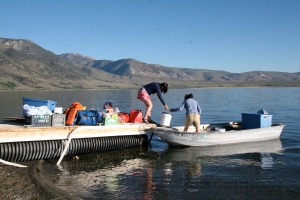
loading the boat
Ann and Kristie climbed on and took the supplies out to the island. I went to another location to be picked up 3 hours later along with the rest of the crew.
Mono Lake is an ancient lake, with a higher salt content than that of Great Salt Lake. Freshwater feeding into it from nearby springs causes calcium carbonate to precipitate out, forming carbonate tufa domes. http://www.monolake.org/
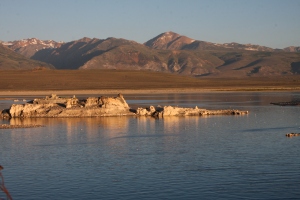
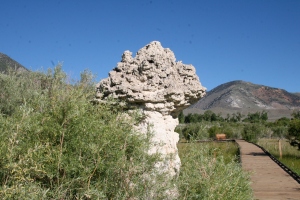
Our field station is on Krakatoa Island, once a movie set for the 1953 movie, “Fair Wind to Java”. The field station is a fake volcano built for the movie. A platform has been added halfway up the in the inside of the ‘volcano’. A storage room, cooking station, washing station, storage shelves, benches have been added. We set out sleeping bags along the outside edge of the platform. To get to the platform requires a climb up the volcanic rock, about 50 feet up from the shoreline. All the gear gets carried up and down the rough path up to the field station from the boat.
The other 4 crew members met up at Mono County Park and carpooled down the road to a parking area. From there, we had a 1/2 mile walk to the water’s edge where Kristie picked us up in the boat. She maneuvered through the tufa towers above and below the water’s surface, slowly moving the boat backwards to the open water. A halfhour ride brought it to our island. Our gear had been off loaded to the shore. We carried supplies up to the ‘volcano’ platform and settled in for lunch and the afternoon break.
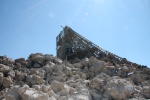
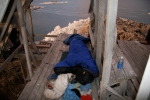
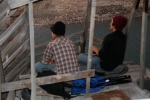
We set out in the late afternoon for our first banding. There are plots set on various islands. The plots are roughly a half acre each and had previously had nest counting in May. Plots are fenced with low fencing. This doesn’t confine the adults in any way but does make for consistent measurement from year to year. This year for the first time, we were going to color band in addition to banding with Fish and Wildlife Service bands (FWS) http://www.pwrc.usgs.gov/bbl/default.htm
The work schedule is set for early mornings and late afternoon/evening, to avoid the worst heat of the day. It’s stressful for both the birds and for us to be working in the heat so we work when it’s cooler. We get up before dawn, start the water for coffee and tea and while we’re watching the sunrise and drinking our morning tea, we make our breakfast.
We were in the boat between 7 and 7:30. The nearest island is only a few minutes away across the straight. The farthest is about 35 minutes away. Paoha is the largest of the Mono Lake islands and has four banding plots. Other islands are on the Negit Island chain and consist of Twain (4 plots with 40% of the nesting colony), Little Tahiti (3 plots), and Little Norway with one plot. A total of 754 chicks were banded this year.
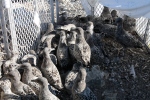
Gull Chicks in Pen, ready for banding
We walked from the boat to the plots in single-file to minimize the disruption to the nesting gulls. There are 20,000 nests on the islands, each about 2 feet apart so everywhere you step you are walking around a nest. When we got to the plot, we set down the gear and erected baby playpen sections to form a corral. We moved in a line from the far side of the plot to corral the babies into the pen. Each of us carried a large or small box or milk crate. If a gull chick tried to get past us, we picked it up and placed it in a box. The smallest chicks were left in place with a box or crate placed over them. They would be banded last. The older chicks find their way back to their nests when they are released after being banded.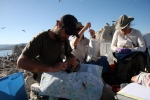
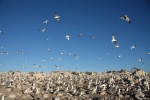
We set ourselves in a rough circle near the pens. Large cardboard boxes were placed by each of the three banders and chicks were placed inside for easy reach by the banders. A recorder and a weigher sat nearby. The handlers moved the chicks from the pens to the boxes, keeping the chicks from piling on each other, keeping the boxes full and moving out empty boxes and replacing them with full boxes. When the FWS band was placed, the blue color band was put on. In almost all cases, the blue band was placed above the FWS band. For the tiniest chicks whose tarsus were too short for both bands, the color band was placed on the opposite leg. For consistency, most FWS bands were placed on the left leg with the color band above it.
We saw and were able to read FWS bands of 5 adults in the plots. Those will be called in to the FWS Banding Laboratory as a report on the current status of those birds.
If anyone reading this sees a gull with a light blue band on its leg, please contact either one of the following people:
Kristie Nelson
storm_petrel@hotmail.com
or Ann Greiner
ann.greiner@gmail.com
When we were nearly done with the largest of the chicks, the handlers would pick up the tiny chicks, leaving the boxes in place as markers of the nest location. These babies were placed back under the box and the box would be removed only when we were ready to leave. The youngest and weakest of the babies are attacked by other babies and by adults as they move through the territories on their way back to their nests. This method of keeping the littlest chicks in place cuts down on the pecking and possibility of death for the tiny ones.
Chicks averaged about 400 gms, but we had one of 45 gms and one of 770 gms. The largest one took off when we finished with it and flew over the fence. We got pooped on, thrown-up on; pecked. One adult threw up a piece of skin (probably fish skin) about 8 inches long and 4 inches wide, taking at least 5 minutes to get it up completely. We all stopped what we were doing to watch. Adult gulls regurgitate their food to feed their chicks, but this piece was too large for any adult or chick to manage.
When we returned to our island for lunch, we washed up and changed into clean clothes and had lunch. Lunch was most often sandwiches of tomato, fresh goat cheese, cucumbers, mayonnaise (despite repeat jokes of ‘gullonnaise’). We would play cards and read and talk and knit and nap. One afternoon we took feathers from a dead gull and toss them into the air off the rocks of our island. A half dozen violet-green swallows flew around catching feathers to line their nests. I tried to catch the aerial ballet of the swallows with my camera and was not altogether successful.

Violet-green Swallow on Tufa
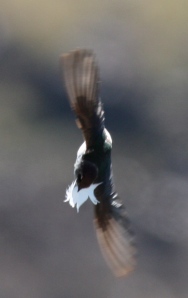
Swallow catching feather
Swallows nested in the crevices of the tufa. Eared grebes sailed by. A prairie falcon visited a couple of the islands. A golden eagle came by and the gulls all left their nests. One night in full dark, we heard the gulls crying and flying and guessed they were being visited by great horned owls. At one plot where we expected few to no nests because of an invasion of ticks, we found one recently dead gull chick. The blood was fresh and red, the inner organs not yet eaten. We must have disturbed the predator in the act of starting to eat a very recent kill. We suspected it was the prairie falcon.
The food was plentiful and excellent, mostly vegetarian with the fresh goat cheese. The company was interesting, intelligent, informative and fun. We woke before dawn and fell asleep shortly after the sun set, and slept well.
It was no hardship waking up before sunrise–dawn was beautiful every morning and sunsets were spectacular. Yes, I would do it again.
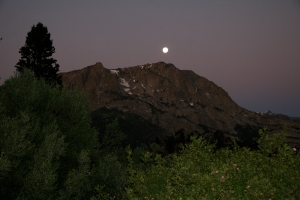
Sunrise over June Lake

Sunrise over Mono Lake

Sunset over Mono Lake